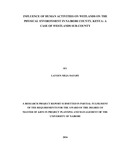| dc.description.abstract | Water is becoming increasingly important within Nairobi area and specifically in Westlands sub-county, which was my main area of research. This is mainly due to the increasing population caused by urban influx, industrialization, expansion and even agriculture and farming in the area. Westlands area is a well formed water catchment zone. The purpose of this study was to assess the influence of human activities on wetlands on the physical environment; while also looking at ways in which wetland utilization can be achieved sustainably. Environmental degradation has had devastating effects on natural resources. One major effect is wetland loss and degradation. This sorry state has to a great extent been attributed to human behaviour (Mwakaje, 2009). Such anthropogenic factors include human activities on wetlands. Westlands sub-county in Nairobi County has experienced a fair share of human encroachment on its wetland resources. The study employed purposive sampling technique. The target population was 5 County government official representatives, 3 Environmental Officers from NEMA and 2 physical planners from Ministry of Devolution and Planning selected through purposive sampling. The sample size was 160 based on Cochrane (2006), selected through the systematic random sampling technique whereby each member of the subset had an equal probability of being chosen. The sample to be used was therefore 28 residents from Kitisuru, 35 from Parklands/ Highridge, 24 from Karura, 40 from Kangemi and 33 from Mountain View constituencies. This formed the basis of this research study. The main instrument used in the study was questionnaires, whose reliability testing was done using the split-half method. The method of data collection was done through administering of questionnaires to respondents, with both closed and open ended questions, which were then collected back and collated for analysis. The data analysis technique used in this study was descriptive statistics, where the data was collated, coded and entered into SPSS system software. Quantitative data was then presented using percentages and frequency distribution tables, while the qualitative data was presented in verbatim statements. It was eminent from the study that human activities on wetlands influence the physical environment; causing detrimental effects such as soil erosion, loss of land cover, water pollution and air pollution; these activities being agricultural activities, construction of public infrastructure and construction of residential structure. Nairobi County thus requires a method in which the problem of wetland degradation in the area is solved, and also long-term measures to ensure satisfaction of human needs for both the current and future generations. This could be done through harnessing the national policies to involve the community in education on the importance of wetland conservation; and also helping in cleaning the wetlands and planting trees upstream to conserve the riparian reserve. Therefore, this research study was not only vital in solving wetland degradation, but also aiding in coming up with solutions to environmental issues associated with wetland degradation. This will in turn enable the community to understand how their encroachment to wetlands has and continues to result in to damaging effects to themselves and to the biological diversity. | en_US |



